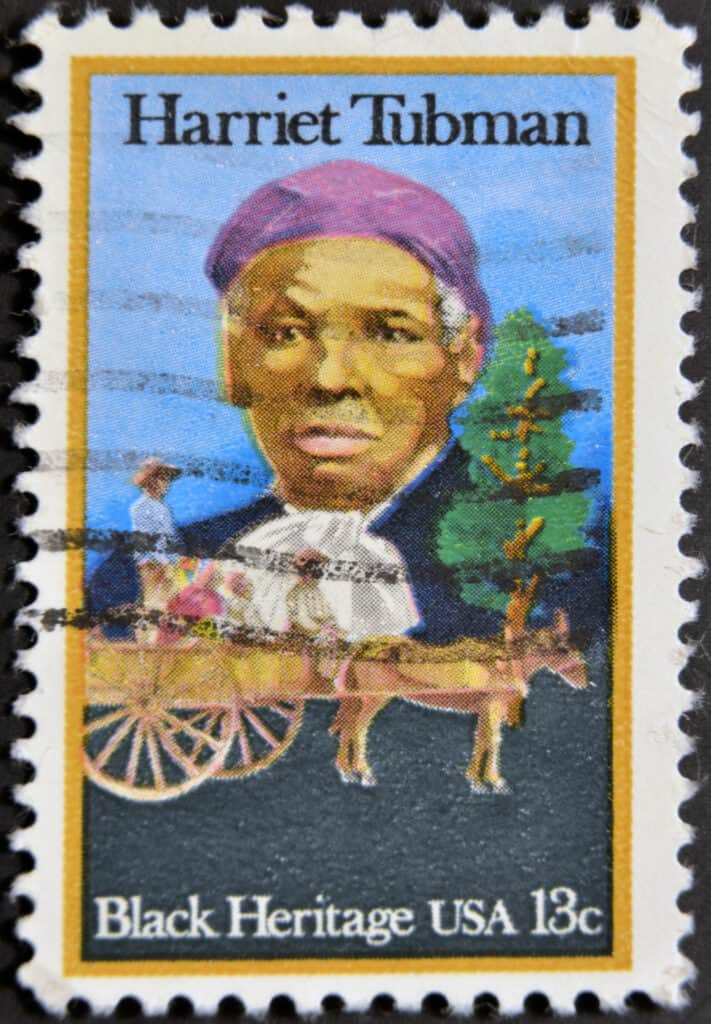Harriet Tubman was an American political activist and abolitionist who had a major impact on American history and the Civil War. During her lifetime, she freed approximately 70 slaves and helped to fight slavery in the United States.
Harriet Tubman died in 1913, surrounded by friends and family. Her last words were: “I go to prepare a place for you.” After her death, Tubman was buried with semi-military honors at Fort Hill Cemetery.

Today, Tubman is seen as an example of extreme bravery and resilience in the face of extreme persecution. She is widely known as an American icon.
Early Life
Harriet Tubman was born as Araminta “Minty” Ross to two enslaved parents, Harriet and Ben, in Maryland. Her exact birth year is unknown but it is estimated that she was born in 1822.
Tubman herself claimed she was born in 1825 while her death certificate claims 1815 and her gravestone says 1820.
Her family had been brought over from Africa a generation before and all she knew was slavery in her early days.
Harriet’s mother was a strong-willed woman who fought hard to keep her family together, even though they were slaves. She had multiple children taken from her and confronted her owners when they tried to take more.
Many believe that her mother’s determination and bravery instilled Harriet’s belief in resistance and fighting for oneself.
Harriet was often beat savagely in her early years. She received lashing scars that she would have for the rest of her life.
Tubman received a major head injury as a kid when she was hit in the head by a two-point metal weight that was being thrown at another slave by a farm overseer.
After being hit by the weight in the back of the head, Tubman experienced painful heads and seizures. She also began experiencing visions and vivid dreams, which she said were a sign from God.
These visions had inspired her to fight for her freedom and the freedom of others.
Escape from Slavery
On September 17, 1849, Harriet and her brothers, Ben and Henry escaped from slavery. Her owners posted a runaway notice for her and offered a $100 reward.
They would eventually return to their owners because the brothers had second thoughts. However, Harriet would escape again by herself.
Harriet used the Underground Railroad to make her escape. This was a secret, well-organized path created by white abolitionists, activists, and freed slaves. It used a series of safe houses to help to escape slaves find freedom.
Tubman traveled only by night and studied the route and the land it was in, becoming an expert on the marshes and forests she needed to get through.
The Underground Railroad
Harriet was free once she made her way into Pennsylvania but her thoughts soon turned to her family and other slaves. She soon began making journeys back into Maryland to retrieve her family and lead them to safety.
Harriet’s work to free slaves grew beyond her family and soon she was escorting other slaves to free regions in the United States and Canada. In December 1851 alone, Harriet guided 11 fugitive slaves to Canada.
Harriet used many techniques and methods to help the escapes. She would come during the winter when most people stay indoors and won’t dare travel through swamps and marshes looking for slaves. She also would take her escapees away on a Saturday night, knowing. newspapers wouldn’t print runaway notices until Monday morning at the earliest.
Each trip put Harriet at extreme risk of being captured, enslaved, or killed. She had a large team of people who helped her plan and gave her a haven but the hardest and most dangerous work was done by Harriet herself.
Over her 11 years freeing slaves, Tubman rescued at least 70 slaves on 13 trips. She was nicknamed “Moses” based on the biblical prophet who freed his people.
Later Life & Death
After her time with the Underground Railroad, Harriet was a major asset to the Union during the American Civil War. She served as a nurse and later led an armed assault on a collection of plantations along the Combahee River.
More than 750 slaves were freed during the Combahee River Raid and Tubman was championed for her hard work, determination, and bravery.
After the war, Harriet spent her later years tending to her family and took on odd jobs to pay the bills and provide a proper living for her loved ones.
She would later fight for women’s suffrage and spoke out in favor of equality.
The activist would continue to suffer from her head injury for the rest of her life and by 1911, her body had become frail and weak. She had undergone multiple surgeries to try and help her brain injury.
Harriet Tubman died of pneumonia in 1913 and was already heralded as a champion of freedom and American civil rights. Her stature among Americans has only grown in the years since her death and she is seen as one of the most important historical figures in the nation’s history.